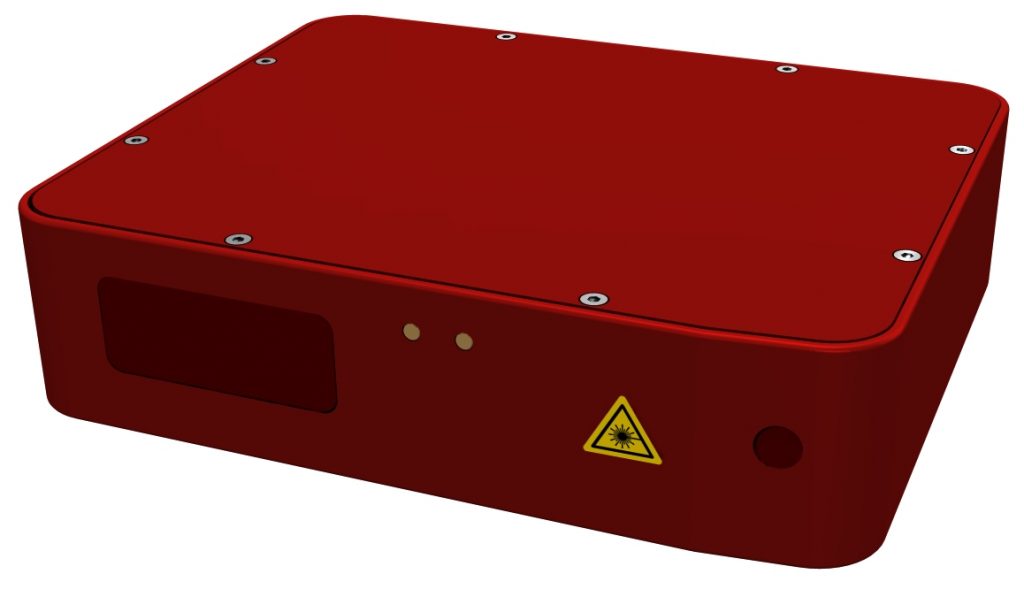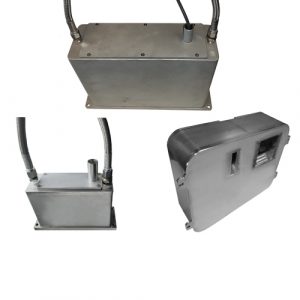ODS Red-Line, a Series of Sensors for the Longer Measurement Ranges. Measures Distance, Thickness or Profiles up to 4 Meters from Sensor.
There are 10 different measuring ranges in this serie. The smallest is 100 mm and the longest i 2000 mm.
The resolution varies from 0.01 mm to 0.5 mm. The smaller the measuring range is, the better the resolution will be. As standard the 1 kHz and 2 kHz models are classified as class 2, which mean that they are not harmful to the human eye. The 10 kHz sensors most be expected to be laser class IEC 3R.

Compared to the other ODS series, the Red-Line sensors are physically bigger, and they are in generally being used for larger measuring ranges or for applications where a longer stand-of distance is needed in combination with high resolution. The three 200 mm models and the 100 mm model are particularly appropriate for thickness/difference measuring in heavy industry, as in connection with cold or hot rolling of steel and metals.
The single sensor is measuring distance to the target, but if two sensors of the same type (or the 4 models mentioned above) are interconnected they will automatically synchronize as a master and a slave unit. If the two sensors are measuring from each side of an object, the master will output the thickness/width variation.
ODS laser Red-Line models are available with measuring frequencies of 1 kHz, 2 kHz and 10 kHz . The higher measuring frequencies meet a demand for better time resolution, in other words a shorter distance between the individual measuring points on a moving target surface. But the motive for using higher measuring frequencies can also be a wish for obtaining higher or the highest possible resolution by averaging the measuring results.
All ODS laser Red-Line models have a Select functionality, meaning that the sensor can be programmed to create a user defined running average before the measuring results are being outputted. Amongst the various filtering possibilities are median filtering, simple average filtering, compressing many data point into a single measurement value, level mode and sample-hold mode. All filters and modes can be combined and calculations are performed before the digital value is converted to the analog output value. Software with every ODS sensor provides easy setting of the Select parameters.
There are 2 simultaneous outputs: One Serial interface, and one analog output, 1–9 VDC or 4-20mA, chosen at the time of ordering. The standard Serial Interface is RS232 or RS422. Ethernet and USB interface can be ordered if the application requires it. RS422 / Ethernet is needed for cable connections over longer distances than app. 10 m.

Distance measurement on target with High Temperature. To meet this demands, the ODS Red-Line family can be modified into High Temperature version to reach different levels of temperature, basically named HT, VHT and VVHT. As a rather unique feature the VVHT version are capable of measuring on extreme hot target surfaces up to 2.200ºC.

Water-cooled protection house is available as extra. To further expand the usability of ODS Red-Line sensors for High Temperature applications, we have developed a water-cooled protection house in stainless steel to enclose the sensors.
The sensor is surrounded on all sides except from the backside by 5 water chambers. This ensures a very effective cooling and protection and allow the sensor to operate close the hot targets like white glowing steel.

The applications where the ODS Red-Line sensors can be used are innumerable. From steel- and metal industry to offshore industry – simply everywhere a non-contact precision distance measurement is advantageous. The sensor is very robust and the housing is made of solid aluminium. Many of the sensors are being used in very harsh environments.
Many ODS Red-Line sensors of various models are used in steel works, measuring on cold and hot steel in various production processes.
A few examples where the ODS Red-Line sensors are being used:
Metal Industry:
Measuring dimension of zinc ingots.
Steel Industry:
Measuring thickness and width of steel slabs.
Rubber Industry:
Measuring position of hot moulds for large tyres.
Manufacturing Industry:
Measuring position of product during processing.
Building Industry:
Measuring ground level on big vehicles.
